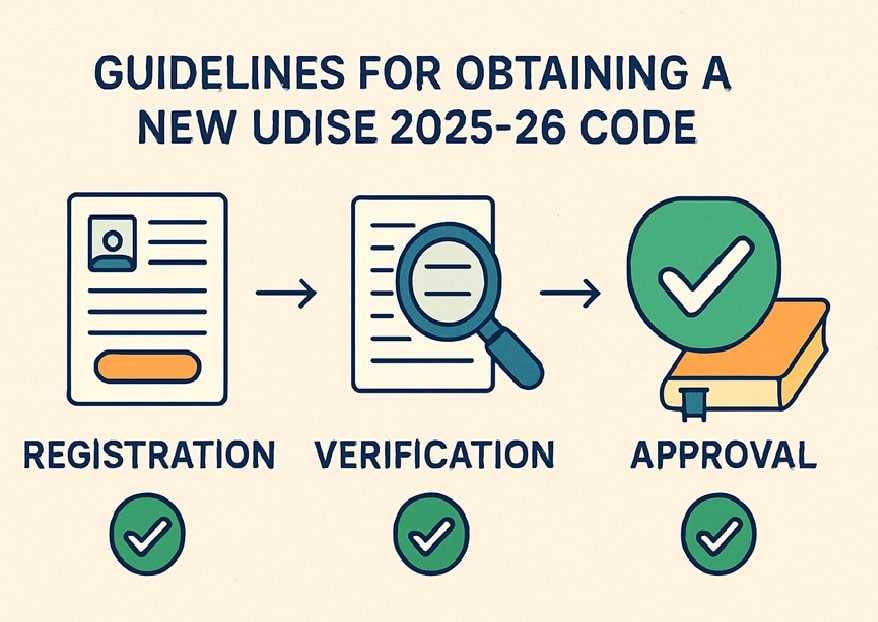
Guidelines for obtaining a new UDISEPlus 2025-26 code.
Revised Student Correction Form S02-UDISEPlus 2024-25 Format for Student Addition
Format for Teacher’s Basic Details Change in UDISE+ Teacher Database TO1
Format for STUDENT Name Change, Class Change and other Basic Details Change in
Format for Student ADDITION in UDISEPlus for Class-2 to Class-12 at Block District
New-Addition-of-Student_Format_UDISE24-25-without-Aadhaar [EXCEL]
UDISEPlus 2024-25: Form for Adding New Students without Aadhaar
Request Form for new UDISE code (Form A02) UDISEPlus 2025-26
Guidelines for Obtaining a New UDISE 2025-26 Code
Streamlining School Registration in India
Introduction
The Unified District Information System for Education (UDISE) is a critical tool for managing India’s school education data, enabling evidence-based planning under schemes like Samagra Shiksha and ensuring compliance with the National Education Policy (NEP) 2020 and the Right to Education (RTE) Act, 2009. The 11-digit UDISE code uniquely identifies each school, facilitating funding, monitoring, and policy implementation. The Request Form for New UDISE Code (Form A02) is essential for registering new schools or those not yet in the UDISE+ database. This article provides clear guidelines for stakeholders – school authorities, Block/District MIS officers, and state-level officials—to ensure accurate submission of Form A02. It also highlights the importance of the UDISE code, and explains its 11-digit structure, from Education for All in India.
Request Form for new UDISE code (Form A02) UDISEPlus 2025-26
Checking Aadhar Mandatory Biometric Update (MBU) Status on UDISE Plus Portal
Why the 11-Digit UDISE Code is Essential
The UDISE code is a cornerstone of India’s educational data ecosystem, ensuring schools are recognized and integrated into national systems. Its key benefits include:
- Funding Access: Enables schools to receive Samagra Shiksha funds for textbooks, uniforms, infrastructure, and RTE reimbursements.
- Data Integration: Tracks enrollment, infrastructure, and teacher data for monitoring and planning.
- RTE Compliance: Supports Private Unaided schools in meeting Section 12 requirements for 25% admissions from economically weaker sections.
- Transparency: Prevents unauthorized schools from operating, ensuring accountability.
- NEP 2020 Alignment: Facilitates data-driven strategies to achieve universal school education by 2030.
Without a UDISE code, schools risk exclusion from government schemes, legal recognition, and affiliation with boards like CBSE, hindering their contribution to India’s education goals.
Structure of the 11-Digit UDISE Code
The 11-digit UDISE code is structured to reflect a school’s geographic and institutional identity:
- Digits 1-2: State code (e.g., 33 for Tamil Nadu).
- Digits 3-4: District code within the state.
- Digits 5-6: Block code within the district.
- Digits 7-11: Unique school identifier within the block.
For example, 33205012345 indicates a school in Tamil Nadu (33), a specific district (20), block (50), and school (12345). This structure ensures precise tracking across India’s diverse education system.
Guidelines for Filling Form A02
Form A02, submitted by Block/District MIS officers, captures comprehensive school details. Below are simplified guidelines for stakeholders:
1. Roles and Responsibilities
- School Authorities: Provide accurate data and documents to MIS officers.
- Block/District MIS Officers: Complete and submit Form A02 with signatures and seals.
- State-Level Officials: Verify submissions and approve/reject requests.
2. Key Sections of Form A02
Basic Details
- Academic Year: Specify initialization year (e.g., 2025-26).
- UDISE District & Block: Use Local Government Directory (LGD) codes.
- School Name & Category: Refer to DCF 1.16 (e.g., Primary, Secondary, Higher Secondary).
- School Status: Operational or sanctioned but not operational.
- Classes & Streams: List lowest/highest classes, pre-primary availability, and streams (Arts, Science, Commerce, Vocational, Others).
- School Type & Management: Boys/Girls/Co-education; Government/Private Unaided; sub-management (DCF 1.14).
- Affiliation & Recognition: Board and number for Secondary/Higher Secondary; recognition status (Permanent/Temporary), year, and number.
- Minority & RTE: Indicate minority-managed status and RTE Section 12 compliance (for Private Unaided schools).
- Medium of Instruction: List up to four mediums (e.g., English, Hindi).
Location Details
- Rural: Revenue/CD Block, Panchayat, Village (per LGD), address, pin code, latitude, longitude, cluster, assembly.
- Urban: Revenue Block (optional), Urban Local Body, Ward (per LGD), address, pin code, latitude, longitude, assembly.
Head of School (HoS) Details
- HoS Type: Refer to DCF 1.11 (e.g., Principal, Headmaster).
- Name & Contact: HoS name, mobile number, school contact.
Officer Details
- Name, designation, signature, and seal of Block and District-level officers (mandatory for validation).
3. Required Documents
Submit documents based on school category and management:
| School Category | Government Schools | Non-Government Schools |
|---|---|---|
| Primary | Government Notification | Recognition Certificate |
| Upper Primary | Government Notification | Recognition Certificate |
| Secondary | Government Notification and/or Affiliation Certificate | Recognition Certificate and/or Affiliation Certificate |
| Higher Secondary | Government Notification and/or Affiliation Certificate | Recognition Certificate and/or Affiliation Certificate |
| Pre-Primary Only | Government Notification | Recognition Certificate |
4. Submission Guidelines
- Avoid Duplicates: Do not submit for schools already in UDISE+ or with pending requests.
- Ensure Accuracy: Incorrect details lead to rejection by District/State MIS.
- Mandatory Signatures: Illegible or missing signatures/seals result in rejection.
- Verification: State officials review submissions, issuing a UDISE code upon approval or rejecting with reasons for correction.
5. Submission Process
- School authorities provide details and documents to Block/District MIS officers.
- MIS officers complete Form A02, ensuring signatures and seals.
- State officials verify and approve/reject, issuing a UDISE code if approved.


